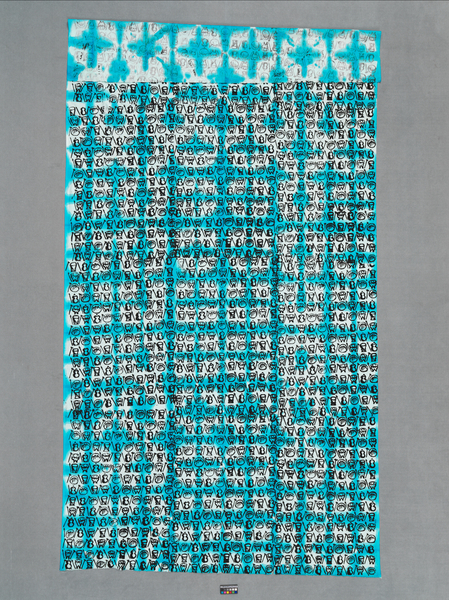Adinkra Cloth Item Number: 3561/2 from the MOA: University of British Columbia

Description
Large rectangular dyed and stamped cloth. The cloth has been dyed with a grid-like turquoise blue pattern (white ground), covered with repeating lines of stamped designs in black. The repeating designs appear to be rows with a spear, drum, axe, drum, spear, gourd(?), axe, circle (thumb piano?), spear, etc., however the order is not always consistent and some of the stamped ink in similar shapes varies a bit from one to another. The long sides are both selvedges; the shorter edges are unhemmed.
History Of Use
In Ghana men wear cloth decorated with Adinkra symbols as wraps. Similar symbols were also traditionally used in decorating ceramics and house facades. The symbols were connected to the Asante, a Twi-speaking people, part of the larger Akan ethnicity. Their culture flourished and developed in relation to their capital city, Kumasi, in what is now Ghana. Kumasi became the centre of the Asante Empire at the end of the 17th century. Adinkra cloth was originally reserved for the Asante aristocracy. Producing it was both labour-intensive and expensive, and interpreting the Adinkra symbols required a high level of visual literacy. Most contemporary Adinkra cloth is now made from industrially milled cotton, printed using traditional processes.
Narrative
Collected by the donor in Ghana, in 1971.
Specific Techniques
The cloth has been patterned using adinkra stamps.
Item History
- Made in Ghana during 1971
- Collected during 1971
- Owned by Susan Stout before April 28, 2022
- Received from Susan Stout (Donor) on April 28, 2022
What
- Name
- Adinkra Cloth
- Identification Number
- 3561/2
- Type of Item
- cloth
- Material
- cotton fibre, dye and ink
- Overall
- height 292.0 cm, width 151.0 cm
Who
- Culture
- Asante
- Previous Owner
- Susan Stout
- Received from
- Susan Stout (Donor)
Where
- Holding Institution
- MOA: University of British Columbia
- Made in
- Ghana
When
- Creation Date
- during 1971
- Collection Date
- during 1971
- Ownership Date
- before April 28, 2022
- Acquisition Date
- on April 28, 2022
Other
- Item Classes
- textiles
- Condition
- good
- Accession Number
- 3561/0002